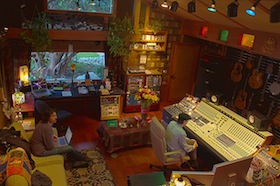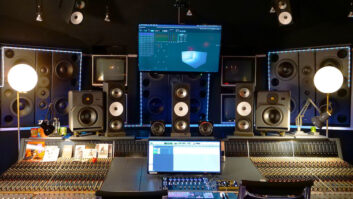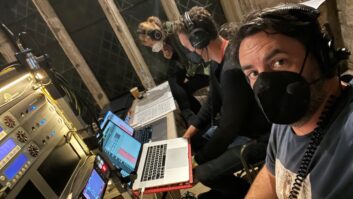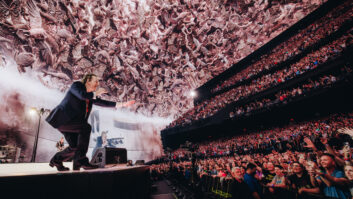
Steve Vai in his Harmony Hut studio.
Steve Vai has married form and function in his new high-end home studio. The fittingly named Harmony Hut, which sits on the grounds of Vai’s estate in the hills above the San Fernando Valley in what was originally the gardener’s quarters, is a direct and vivid reflection of the guitarist/gearhead’s personality and taste—manifested in his dual passions for aesthetics and technology. Dark wood paneling, Tiffany lamps and shelves filled with leather-bound books give the control room a warm, elegantly understated vibe closer in feel to a library than a recording studio.
“If I’m gonna come here every day, I want to feel good,” Vai says of this self-designed environment. “You make it comfortable and it’s easier to be creative. When I wanted to create a working environment, I was very set on having the freedom of expressing all the different aspects of that space. The music, obviously, is the most important thing, but I find it very enjoyable to weave the environment, the equipment—which has always fascinated me—and every other element in finding what feels good, what feels right.”
The posh decor complements a fully functional workspace whose most striking foreground feature is a custom-designed Tree Audio 32-channel console, dramatically framed by a pair of monolithic Ocean Way monitors. The board is strikingly finished in sea-foam green, inspired by an antique T-Bird Vai once spotted in a parking garage. “The color was so rich it was like candy,” he recalls with characteristic enthusiasm. “I wanted to taste it.”
Tree Audio’s Steve Firlotte and Ian Gardiner designed the console, making full use of Vai’s minutely detailed input. The 16 channels on the left are paired with a series of slots that accommodate 500 Series modules; the 16 on the right are Neve-style buckets. Firlotte and Gardiner have loaded Vai’s board with clever touches, like placing the EQ knobs on the bottom row rather than across the top so that they can be reached without leaving the listening window. Putting on his Inward Connections hat, Firlotte custom-designed a 4-band EQ for Vai that he dubbed the Buster. The artist/producer and his engineer Greg Wurth also made extensive use of Inward Connections’ 500 Series Vogad and Brute compressors and Magnum mic pre during the sessions for his most recent release.
Opening the door that separates the control room from the surprisingly spacious tracking room, Vai says, “It’s like the Guitar Center.” [Laughs.] He’s referring to the jaw-dropping guitar gallery that takes up two of the studio’s walls from floor to ceiling—row upon row of axes, organized with OCD precision, behind virtually invisible Plexiglas shields. Likewise, cabinets built into one wall are crammed with every conceivable stomp box—“a guitarist’s wet dream,” as Vai puts it—adjacent to a well-stocked mic locker. He then points out the absence of perpendicular angles in the walls and peaked ceiling. “I did a lot of research to discover the best angles and surfaces to get the sound that’s most conducive to what I like,” he explains. “We used this very interesting chart that gives you the various reflective densities—wood, glass, stone, fabric—and how to blend them to get the sounds you want.”

Steve Vai
Photo: Larry DiMarzio
Vai broke in his new studio making The Story of Light (released Aug. 14 on his own Favored Nations label), his 16th solo album and the second volume of a projected trilogy, following 2005’s Real Illusions: Reflections. Seven years may seem like a long stretch between studio albums, but Vai has spent the time fruitfully, touring extensively behind the previous album, painstakingly composing and orchestrating a pair of commissioned works for two Dutch symphony orchestras, 2007’s Sound Theories Vol. I & II and 2011’s The Middle of Everywhere. Between those ambitious undertakings, Vai assembled a band and wrote the music for the Where the Wild Things Are tour and live album in 2009. With those projects out of the way, he was finally able to begin gathering ideas for the middle album in the trilogy, the whole of which he’d conceptualized back in ’05.
In January 2011, as Harmony Hut was in the final stages of construction and outfitting, Vai spent three months demoing material for The Story of Light at The Mothership, his API-equipped studio in Hollywood. He then switched over to the new facility and began recording in earnest, finishing this past April. During the year Vai spent here at Harmony Hut, technology and aesthetics collided, setting off sonic fireworks—though in an extremely deliberate manner.
“I don’t record tracks; I build them,” he says of his architecturally rigorous recording methodology. “I get a full picture of what I want a track to be, and that tells me how to build it. What I do for the most part is lay down a click or a drum machine as a groove, and I put a scrap guitar on it, and maybe scrap bass and keyboard as well. Then I’ll bring in my drummer, Jeremy Colson, and build the track with him.”

Story of Light album cover.
And build he did. Vai reckons there are upwards of 80 voices on “The Book of the Seven Seals,” while “No More Amsterdam,” which has Aimee Mann on lead vocals, “has 25 different guitars, probably—half the models on that wall.” At the other extreme is “Sunshine Electric Raindrops,” which has just one guitar, “but it’s as big as a house,” he notes.
Taking in his sonic sanctuary, Vai turns reflective. “This room could be a cardboard box, and it might make somebody perfectly happy, because they don’t want to see all the books and colored lights—it’s too distracting to them, and that’s completely valid,” he says. “They might just want to record onto ADAT. There’s nothing right or wrong about it—it’s all valid, it’s whatever somebody wants. But this is what I want. This is what I’m comfortable with.”







